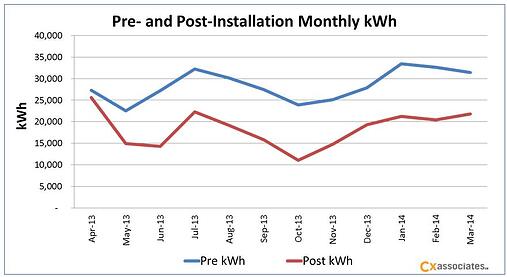Part of a marketing stumbling block in our commissioning field is the lack of quantifiable benefits to our work. People understand commissioning will enable their systems to work more smoothly, generating less maintenance issues and longer equipment life. People understand that commissioning will benefit their building with more comfort for their tenants and finer temperature and humidity control for their processes. But quantifying any energy reduction attributed to commissioning is usually not in the project’s budget and is all too often forgotten when everyone moves on to new projects.
Retrocommissioning Energy Savings Calculations
Retrocommissioning is the commissioning of existing buildings. For energy savings, an existing building has the highest potential for hard evidence of the impact commissioning has on a system. Typically, we meter the equipment prior to the retrocommissioning work and then meter it again afterwards. Weather and process loads are taken into account to “normalize” the data and energy savings are the difference between the normalized pre-installation consumption, and the normalized post-installation consumption.
Retrocommissioning Success Stories
We have worked with a number of buildings that have quantified energy savings attributed to retrocommissioning. In this post, I would like to highlight two of them in our city of Burlington, Vermont.
The first building is a 60,000 sf 100-year old brick building (retail space on the first floor and office spaces on the other floors) with a central hot/chilled water plant that serves individual tenant heat pumps. The owner pays the bills for the central plant and the tenants pay for their heat pumps. The central plant has 60 and 75 horsepower pumps that were constant speed and a manual diverter valve that sent 80% of the water through the boilers for the winter months. This boiler water divergence was set arbitrarily when the preventative maintenance was conducted in fall and spring. Our project included controls and variable speed drives on the central and condenser water pumps, and a circulating pump and controls on the boiler. These boiler controls enabled the boilers to fire and receive water only when required by the building water return temperature. The pumps were also controlled by supply and return water temperatures and static pressure downstream of the pumps.
For the past three years, the central plant savings have consistently been around 45% in heating savings (natural gas) and 31% in electrical savings. The payback of this project is less than 2.5 years. In addition, the facilities manager is relieved that the pumps are less noisy and are not shaking the building when they operate!
The other building is a 100,000 sf brick building that is a library. This building has a combination of air handling units and fancoil units that were not controlled well. Retrocommissioning was conducted on a portion of the air handling systems and annual energy savings of 18% have been generated consistently for the past three years. In addition, building occupants are more comfortable, alarms are being communicated, and maintenance issues are reduced.
Savings Are Consistent, Simple, and Real
Big energy savings are available from small building retrocommissioning. These projects are examples that are common and impressive: savings attributable to retrocommissioning are quantifiable and not difficult to implement. The measures we executed in these two buildings are very standard – contractors are comfortable with the work and equipment is easy to purchase. We may need to keep quantifying the savings to prove to building owners why it’s in their interest to invest in their systems for a while, but some day (hopefully soon) the energy savings impact of retrocommissioning will be an accepted norm.





